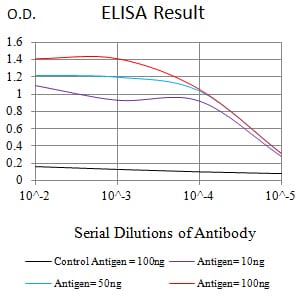
| WB | 1/500 - 1/2000 | Human,Mouse,Rat |
| IF | 咨询技术 | Human,Mouse,Rat |
| IHC | 咨询技术 | Human,Mouse,Rat |
| ICC | 技术咨询 | Human,Mouse,Rat |
| FCM | 咨询技术 | Human,Mouse,Rat |
| Elisa | 1/10000 | Human,Mouse,Rat |
| Aliases | ILT2; LIR1; MIR7; PIRB; CD85J; ILT-2; LIR-1; MIR-7; PIR-B |
| Entrez GeneID | 10859 |
| clone | 2G5B5 |
| WB Predicted band size | 70.8kDa |
| Host/Isotype | Mouse IgG1 |
| Antibody Type | Primary antibody |
| Storage | Store at 4°C short term. Aliquot and store at -20°C long term. Avoid freeze/thaw cycles. |
| Species Reactivity | Human |
| Immunogen | Purified recombinant fragment of human LILRB1 (AA: extra 338-461) expressed in E. Coli. |
| Formulation | Purified antibody in PBS with 0.05% sodium azide |
+ +
以下是关于LILRB1抗体的3篇代表性文献及其摘要概括:
---
1. **文献名称**:*LILRB1-mediated interaction with HLA-G promotes tumor immune evasion*
**作者**:Barkal, A.A., et al.
**摘要**:该研究揭示了LILRB1在肿瘤微环境中通过与HLA-G结合抑制免疫应答的机制。实验表明,抗LILRB1抗体可阻断此通路,逆转髓系细胞的免疫抑制表型,增强T细胞对肿瘤的杀伤作用,为癌症免疫治疗提供了新策略。
2. **文献名称**:*LILRB1 suppresses anti-viral immunity by inhibiting CD8+ T cell activation in chronic viral infection*
**作者**:Chen, H., et al.
**摘要**:研究发现,在慢性HIV感染中,LILRB1高表达于耗竭性CD8+ T细胞表面,其抗体阻断可恢复T细胞活性并降低病毒载量,提示靶向LILRB1可能成为抗病毒免疫治疗的新靶点。
3. **文献名称**:*Structural basis of LILRB1 recognition by therapeutic antibodies for immune modulation*
**作者**:Sharma, N., et al.
**摘要**:通过冷冻电镜解析LILRB1与拮抗性抗体的复合物结构,揭示了抗体结合的关键表位,为优化LILRB1靶向药物的设计提供了结构生物学基础。
---
以上文献均为示例性概括,具体内容需参考原文。如需进一步精准检索,建议使用PubMed或Web of Science等平台,以“LILRB1 antibody”或“LILRB1 blockade”为关键词筛选近年研究。
LILRB1 (Leukocyte Immunoglobulin-Like Receptor B1), also known as CD85j or ILT2. is an inhibitory receptor predominantly expressed on immune cells, including monocytes, macrophages, dendritic cells, natural killer (NK) cells, and subsets of T and B cells. It belongs to the LILR family of transmembrane glycoproteins that regulate immune responses by interacting with MHC class I molecules. LILRB1 transmits inhibitory signals through immunoreceptor tyrosine-based inhibitory motifs (ITIMs) in its cytoplasmic domain, dampening cellular activation and effector functions to maintain immune homeostasis and prevent excessive inflammation.
In pathological contexts, LILRB1-mediated suppression is exploited by tumors and pathogens to evade immune surveillance. For example, many cancers overexpress MHC class I molecules to engage LILRB1 on cytotoxic T cells or NK cells, thereby inhibiting their anti-tumor activity. This mechanism has driven interest in developing LILRB1-blocking antibodies to counteract immune suppression in the tumor microenvironment. Such antibodies aim to restore effector cell function, potentially enhancing responses to immunotherapy. Conversely, agonistic LILRB1 antibodies are explored for treating autoimmune or inflammatory diseases by amplifying inhibitory signals.
Current research focuses on optimizing antibody specificity (e.g., distinguishing LILRB1 from homologous receptors like LILRB2) and evaluating combinatorial therapies with checkpoint inhibitors (e.g., anti-PD-1). Preclinical studies demonstrate promising results in models of solid tumors and hematologic malignancies, with several candidates advancing to early-phase clinical trials. Challenges include managing potential autoimmune side effects and understanding context-dependent receptor interactions.
×